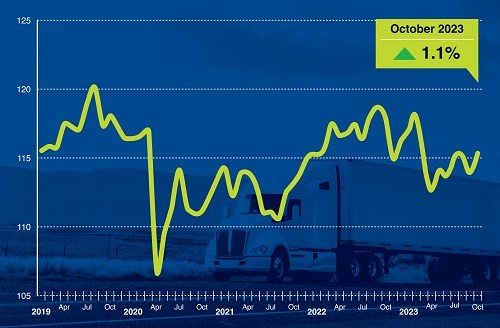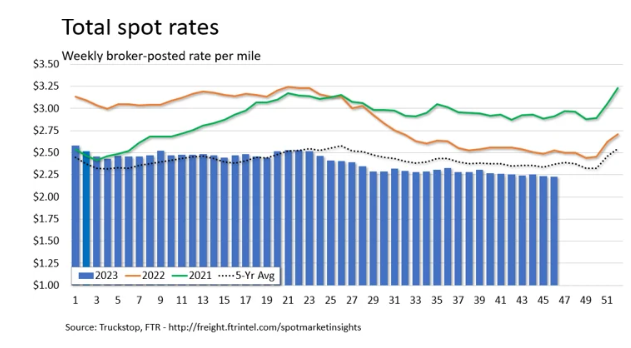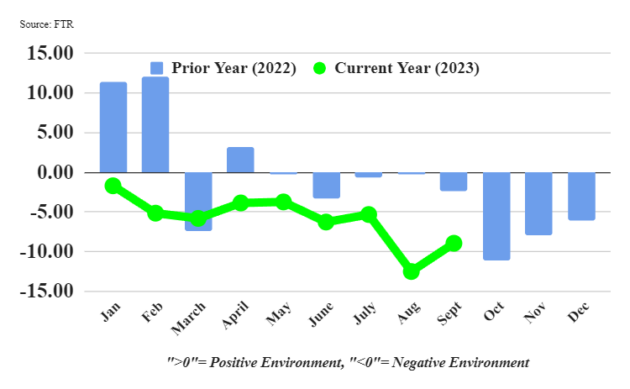Economic Trucking Trends: Tonnage and trucking conditions improve, but spot market flat
Welcome to a special Monday edition of Economic Trucking Trends, as I, like many of you, chose to park it over the U.S. Thanksgiving holiday. But the economic news didn’t take a break; there’s lots to report this week.
Highlights include modest improvements in for-hire truck tonnage and overall trucking conditions, but a spot market that failed to delivery a pre-Thanksgiving boost. Overcapacity remains an issue but that excess capacity is being eliminated faster than expected, according to ACT Research, setting the stage for a brighter 2024.

U.S. truck tonnage edges upward
For-hire truck tonnage in the U.S. edged up in October by 1.1% from September levels, recovering the 1.1% it lost the prior month.
“After hitting a floor in April, tonnage has slowly and inconsistently improved, but remains 3% below its recent peak in September 2022,” said ATA chief economist Bob Costello. “Despite the monthly gain, truck freight remains soft as it continues to contract on a year-over-year basis. It is important to remember that our for-hire truck freight index, which includes both truckload and LTL freight, is dominated by contract freight with minimal amounts of spot market loads. The traditional spot market remains much weaker than contract tonnage.”
Truck tonnage was down 2.1% year over year, the eight straight YoY decrease.
Trucking conditions improving
Looking beyond freight volumes alone, at five metrics affecting the U.S. truckload market, FTR noted trucking conditions improved in September. Its Trucking Conditions Index moved from -12.54 in August to -8.97 in September, mostly due to more stable fuel prices and modestly stronger freight demand.
But FTR notes conditions are expected to remain tough for truckers with negative readings of the TCI into late 2024.
“The TCI was less negative in September principally because fuel costs did not rise as much as they did in August, but trucking companies saw no real improvement in freight market conditions,” FTR vice-president of trucking, Avery Vise, noted in a release.
“Although carriers today are seeing some temporary relief due to the recent drop in diesel prices, freight rates look to improve only gradually over the next year. The trucking industry continues to struggle with more capacity than is ideal given sluggish freight volume. Many operations apparently are hanging on or maintaining driver levels in hopes of a near-term rebound, but that approach amounts to an increasingly high stakes game of chicken.”

Spot market lags expectations
Heading into the U.S. Thanksgiving holiday, the U.S. spot market fell short of expectations, according to Truckstop and FTR Transportation Intelligence. For the week ended Nov. 17, expected rate strength leading into the holiday failed to materialize.
In fact, van rates were lower during the week while refrigerated rates were flat.
“Spot rates for both equipment types typically rise significantly during the week before Thanksgiving; refrigerated rates occasionally surge 10 cents or more heading into one of the biggest food-centric holidays of the year,” the companies reported.
“Capacity shortfalls during Thanksgiving week usually mean higher dry van spot rates, but weakness in the latest week raises doubts about that outcome. Refrigerated spot rates are still the highest since the week before Labor Day, but dry van rates are at their lowest level since the week before the International Roadcheck inspection event in May. Meanwhile, flatbed spot rates are still slightly below the five-year average but narrowly outperforming seasonal expectations.”
Truck postings increased, driving the Market Demand Index down to 48.2, its lowest level since August.
Trailer orders reach 2023 high
Trailer orders of nearly 34,400 units in October marked the best month of orders seen this year, according to FTR, with orders spiking about 6,000 units from September levels but still 21% off the same month in 2022.
Build increased by 4% but still lagged orders, increasing the backlog for only the second time this year.
“Trailer backlogs relative to production levels overall are in line with normal levels historically, but they vary notably by trailer type,” said Eric Starks, FTR chairman. “The backlog-to-build ratios for van trailers are still elevated and should support current production levels. The ratios are much lower for more specialized trailer types, raising concerns over possible cuts in production down the road. On the plus side, the order increases in October for most specialized trailer types greatly outperformed dry van and refrigerated van trailers.”
A look ahead
In its latest Freight Forecast, U.S. Rate and Volume Outlook report, ACT Research reported freight markets will continue bouncing along the bottom in the near term.
“We see retail sales turning back to real growth this holiday season, after over a year of declines,” said Tim Denoyer, ACT’s vice-president and senior analyst, in reference to the report.
“The acceleration in real disposable income growth as inflation slowed sharply this year, and the ongoing strong labor market, support a recovery in goods demand. The end of destocking, rise in imports, and recent easing in oil prices improve our confidence that peak season will end on a higher note for freight demand. But although private fleet capacity expansion continues to pull freight from the for-hire market, we think equipment purchasing patterns are changing, which should propel the freight cycle forward in 2024.”
ACT reported an acceleration of overcapacity removal, thanks to slowing Class 8 tractor sales and an elevated pace of fleet exits from the market.
“With freight volumes broadly starting to pick up, the spot market is still loose heading into winter, but we expect the trajectory of rates to shift in 2024,” Denoyer concluded.
Have your say
This is a moderated forum. Comments will no longer be published unless they are accompanied by a first and last name and a verifiable email address. (Today's Trucking will not publish or share the email address.) Profane language and content deemed to be libelous, racist, or threatening in nature will not be published under any circumstances.

Trucking rates are too low in Canada and Europe at this time unless a plan is in place for better wages and treatment of drivers. We will more cheap offshore truck drivers often as students. The U K is working on a plan that foreign workers that are not from Europe or Australia need to make over 800 lbs a week or go back at the end of te year
Canada needs to do the same for foreign workers making under $27 cd per hour if bot from Australia or the U K and the low rates and homeless with jobs will disappear in my opinion.